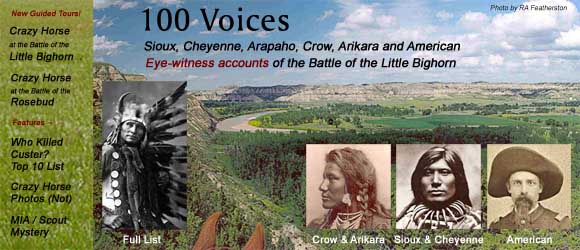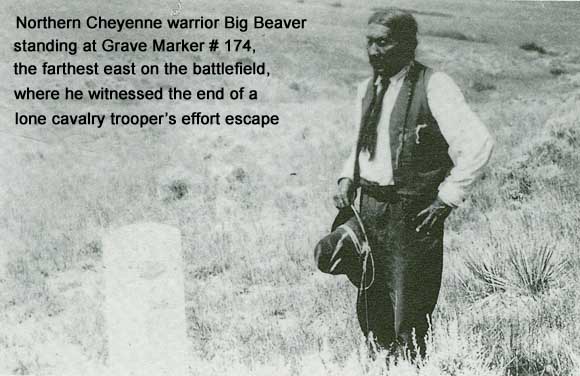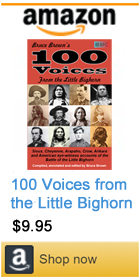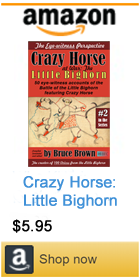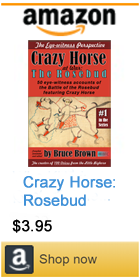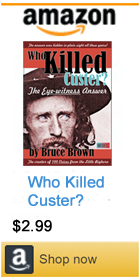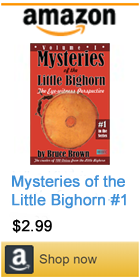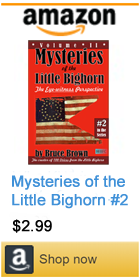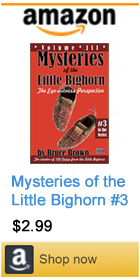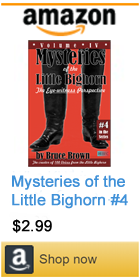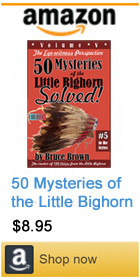|
||||||||||||
Bruce Brown's 100 Voices... Big Beaver's Story of the Battle
THE BIG BEAVER INTERVIEW Custer Battlefield, Montana, 1928 DR. THOMAS MARQUIS and I had done much investigation of the Custer and Reno battles. Dr. Marquis was the doctor at Lame Deer for several years, and he became one of the best sign language talkers that I ever came in contact with. While at Lame Deer, he became acquainted with quite a few Cheyenne Indians who were in the Custer and Reno battles. And having befriended some of them, he gained their confidence and gradually, a little at a time, they would tell about the Custer battle. For a long [time], the old Indians were afraid that the government would punish them if the government found out which ones were in the battle. Now, the Doctor and I were quite intimate friends, and he told me lots of things in confidence. It took him two years before he could find out much about the fights. I will now take up the story of Big Beaver as told to us in the summer of 1928. Dr. Marquis and Big Beaver came to my place, the store at Garryowen, Montana, and were there with me three days, and each day we would go over the battlefields and Big Beaver would tell us what he knew about the battle and what he saw. He was very careful to tell us each time as to what he saw, or whether it was something he heard the other Indians say. I will only give the part he says he saw or took part in. The first he remembers is that [which took place] on the day the soldiers came. In those days, the Indians had no way of telling the days or months or time of day as we use them. We have to take it [therefore] the way they remember it, or their way of expressing it. Word was brought that soldiers were coming to fight them. He says he was about seventeen years old at the time. He started to get his pony to go in the fight. His father told him, "Son, you are too young to fight, and as there are lots of fighting men there, they will not need you." But he went anyway, having only a bow and arrows, as up to this time he never had a gun. He says many Indians in the fight did not have a gun. As the Cheyenne camp was the one on the north or lower end of the great Indian camp, this made them the nearest to the [Custer] battleground. He says all the Indians from this end of the camp went north along the river, thence to the right or east, and came up towards Custer from the north side. When he got there, he left his pony back some distance and crawled up the coulee just north and a little to the east of where the present monument is. He described a Sioux with a warbonnet as being just ahead of him. This Sioux would jump up and shoot towards the soldiers on the hill where the monument is; then he would fall down and reload, and crawl ahead again. He did this several times. Big Beaver said he was close behind him when he jumped up to shoot again when a bullet struck him in the forehead. He then described just where the bullet hit the Sioux. Then he said, "I thought it was no place for me," so he turned and crawled back. [Note: Cheyenne warrior Wooden Leg witnessed this scene. Here is his account of the same moment in the battle.] Then he says a soldier got up and mounted his horse (this was one of [Capt. Myles] Keogh's men, or Sorrel Horse Troop), and rode as fast as he could towards the east. This is the lone marker next to the fence to the east of the Keogh position. Two Cheyenne Indians cut him off and killed him. He then described how they scalped him and hung the scalp on the sagebrush. He says he then went over there and got the gun and some other things, and that was the first gun he ever owned. When he returned to where the other Indians were in the coulee, he saw them all rushing up towards the hill where the monument is. He stated that he went up also, and when he got up there no soldiers were standing up, but some were still firing that were on the ground or sitting up. The Indians rushed them, and that was the end there, but, he says, some men, about fifteen, got up over to the west, or on the E Troop position, and ran for the river, right down the coulee. He says these soldiers were scared as they did not shoot back, and that the Indians ran them down. Now, these men were out of ammunition and could not shoot back [and] they were trying to make it to the brush along the river. That is the way he saw it, he says-they just ran towards the river. To me, these men made a rush towards the river to try to save themselves by hiding in the brush on the riverbank. My idea is that they used all their ammunition and were making this last effort to get away. These markers [for these slain men ] are the last seventeen markers down the coulee, southeast [southwest] of the monument. He knew nothing about the rest of the battlefield as , he says , the smoke and the dust were so thick he could not see very far. All the Indians from farther back had come upon the field by this time and everyone was trying to get something. On June 26 , he was up at the Reno field but did nothing there as he could not get near the troops. Cheyenne Memories of the Custer Fight: A Source Book by Richard G. Hardorff, The Arthur Clark Co. Spokane, WA 1995, p 143 - 150
Big Beaver was one of the youngest particiants in the battle, and he fled as soon as he saw real gore.
|
||||||||||||



